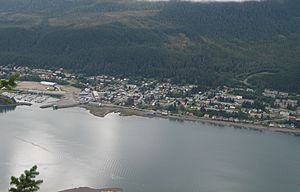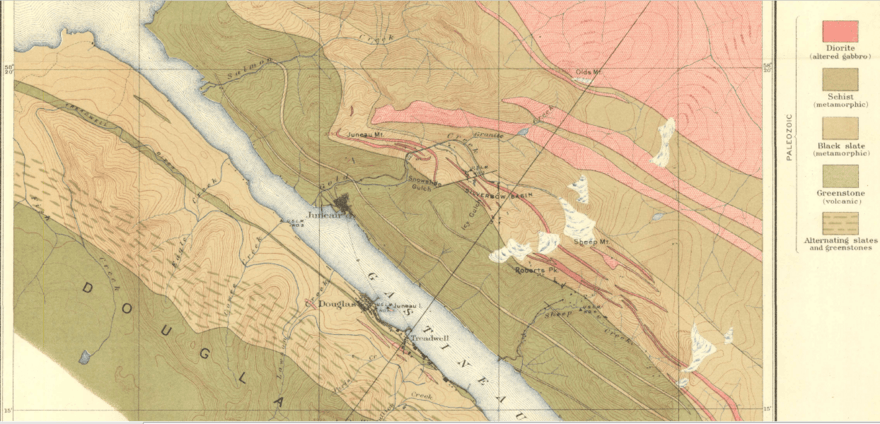Douglas, Juneau, Alaska facts for kids
Quick facts for kids
Douglas
|
|
|---|---|
|
Subcommunity, former incorporated city
|
|

Overhead view of the Douglas townsite from the Mount Roberts Tramway, August 2010
|
|
| Country | United States |
| State | Alaska |
| Municipality | City and Borough of Juneau |
| Founded | 1881 |
| Incorporated | March 29, 1902 |
| Incorporation dissolved | July 1, 1970 |
| Government | |
| • Type | Part of unified home rule municipality |
| • Body | Assembly |
| Population | |
| • Estimate
(2011)
|
3,000 |
| ZIP Code |
99824
|
| Area code(s) | 907 |
Douglas is a community located on Douglas Island in southeastern Alaska. It sits directly across the Gastineau Channel from downtown Juneau. This area has a rich history, especially linked to the gold rush days.
Contents
Douglas: A Gold Rush Town
Douglas Island was originally a border area for the Auke people and Taku people. They didn't usually live there all year. Instead, they used it as a summer spot or sometimes for battles.
Some old reports say an early settler might have given Douglas Island its name.
The Gold Rush and New Towns
In 1880, gold was found in Juneau, Alaska, just across the narrow Gastineau Channel. This discovery brought many people hoping to find gold and get rich. By 1881, two towns quickly grew on Douglas Island: Treadwell and Douglas.
Treadwell was mainly for the miners. It had its own places for fun, like a pool and a bar. Douglas also saw many businesses open up. Soon, it had its own school and a post office. A railroad and a boardwalk connected the two towns.
At this time, the Treadwell power plant was huge! It provided electricity for the entire Treadwell area, Douglas, and even Juneau. This power plant kept working for the Alaska-Juneau Gold Mining Company until 1944. The War Department closed the mine because it wasn't needed for the war effort.
Changes and Challenges
In 1887, the Douglas Island Friends Mission School was started. This school aimed to teach Indigenous Alaska Native children Western culture. However, it closed in 1902. Later, this site became a dairy farm.
The city of Douglas officially became a city in 1902. On March 9, 1911, a big fire started in the Douglas Grill. Firefighters from Douglas, Treadwell, and Juneau had to work together to stop the whole town from burning down.
After a major cave-in at the Treadwell gold mine in 1917, the towns of Douglas and Treadwell changed. One part of the mine kept running until 1926, but Treadwell became much smaller. Douglas then became the main town on Douglas Island.
Douglas had its own dairy, Douglas Dairy, until 1923 when it moved across the channel. Back then, a regular ferry boat traveled between Juneau and Douglas.
On October 10, 1927, another large fire swept through Downtown Douglas. It destroyed part of the old Treadwell Mine, the main business area, and the Native Village.
In 1935, the Juneau-Douglas Bridge opened. This made it much easier to travel between Douglas Island and Juneau.
On February 23, 1937, Douglas faced yet another terrible fire. About 600 out of 700 residents lost their homes. But the people of Douglas rebuilt their town and started over.
In March 1955, the city decided to combine its schools with Juneau's. This led to the building of Juneau-Douglas High School, which still serves students in the area today.
In May 1962, the Douglas City Council burned the Tlingit Indian Village of Douglas. This village was known as Anax̱ Ya Andagan Yé, which means "Where Sunlight Touches First."
Joining Juneau
In 1970, voters in Douglas and Juneau, along with the surrounding Greater Juneau Borough, decided to combine their governments. This created the City and Borough of Juneau as it is today.
Douglas Today: Community and Life
Douglas is now part of the City and Borough of Juneau. It has a population of about 3,000 people. This is about ten percent of Juneau's total population.
Population Changes Over Time
| Historical population | ||
|---|---|---|
| Year | Pop. | ±% |
| 1890 | 402 | — |
| 1900 | 825 | +105.2% |
| 1910 | 1,722 | +108.7% |
| 1920 | 919 | −46.6% |
| 1930 | 593 | −35.5% |
| 1940 | 522 | −12.0% |
| 1950 | 699 | +33.9% |
| 1960 | 1,042 | +49.1% |
| 1970 | 1,243 | +19.3% |
| Source: Absorbed into Juneau, Alaska, 1970 |
||
Douglas first appeared on the U.S. Census in 1890 as "Douglas City." It officially became a city in 1902. Over the years, its population changed quite a bit. For example, in 1910, Douglas had 1,722 residents, which was more than Juneau at that time! If Douglas, Juneau, and Treadwell had been one city then, they would have been the biggest city in Alaska.
In 1970, the people of Douglas and Juneau voted to merge. This means Douglas is no longer a separate city but a community within the larger City and Borough of Juneau.
Local Services and Attractions
Douglas has its own elementary school, Gastineau Elementary. It is part of the Juneau School District and serves all elementary-aged students on Douglas Island. The Douglas Public Library is also part of the Juneau Public Library System.
The community has a small downtown area with several restaurants and bars. There's also a gas station. Douglas is home to the Perseverance Theatre, which is Alaska's only professional theater company.
Douglas gets its water and electricity from Juneau. It also has systems for treating wastewater. The Alaska Department of Corrections has its main office in Douglas.




